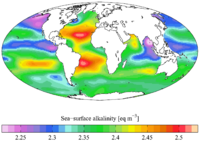
Photo from wikipedia
Abstract Rare earth elements plus yttrium (REY) mass fractions of ancient carbonate rocks are used to track changes in chemistry of past seawater. Here we investigate REY patterns in two… Click to show full abstract
Abstract Rare earth elements plus yttrium (REY) mass fractions of ancient carbonate rocks are used to track changes in chemistry of past seawater. Here we investigate REY patterns in two carbonate sections from the Ediacaran Bambui Group, Sao Francisco Basin (Brazil), which comprise its two lowermost transgressive-regressive second-order sedimentary sequences. Shale normalised distributions vary with the sequence stratigraphy framework. In the basal 2nd-order sequence, carbonate samples from the basal sequence transgressive systems tract display light REY (LREY) distributions slightly depleted to enriched that reflect input of freshwater, possibly in a post glacial episode. Upwards, carbonate rocks from the early highstand systems tract (EHST) yielded LREY enriched distributions, which progressively turns into LREY shale normalized depleted distributions on samples from the late highstand systems tract (LHST). This portion of the sequence also displays Y positive anomaly in some cases. Carbonate samples from the upper second-order sequence do not display coherent patterns. Ce/Ce* values > 1 in most samples throughout the two sections suggest permanent anoxia of seawater. The REY change from the EHST to LHST in the basal sequence marks an important paleoenvironmental overturn in the basin, with increasing alkalinity in seawater driving REY fractionation and LREY depletion. Confinement of the basin in the inner areas of West Gondwana due the uplift of marginal neoproterozoic orogens probably changed the weathering style of source areas to more congruent, thus delivering a higher ionic influx to a restricted setting, increasing alkalinity during LHST. Cloudina sp. fragments were reported in this stage of the Bambui Group and in carbonate rocks with high Sr mass fractions in other West Gondwana basins, supporting the hypothesis that the high alkalinity of seawater during late Ediacaran may have driven the appearance of the first biomineralizing organisms.
Journal Title: Precambrian Research
Year Published: 2020
Link to full text (if available)
Share on Social Media: Sign Up to like & get
recommendations!